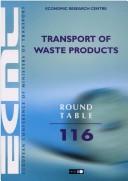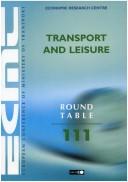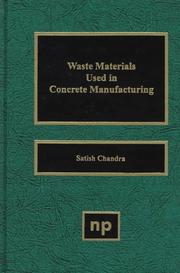| Listing 1 - 10 of 29 | << page >> |
Sort by
|

ISBN: 1280080833 9786610080830 9282112853 9282113647 Year: 2001 Publisher: Paris : OECD Publishing,
Abstract | Keywords | Export | Availability | Bookmark
 Loading...
Loading...Choose an application
- Reference Manager
- EndNote
- RefWorks (Direct export to RefWorks)
With the treatment of waste set to increase -- since the volume of waste is closely related to economic growth -- waste transport will be a major challenge in the future. This raises several issues. Should transport regulations be made more stringent and their implementation reviewed? Should the proximity principle -- incorporated in the regulations in the interests of environmental protection -- be questioned, since it prevents the consolidation of flows in sufficient volume to make the most environmentally-friendly modes of transport viable? The environmental performance of waste transport can be established only within the framework of an overall approach which incorporates all waste treatment routes. We must indeed be wary of seemingly good ideas such as "waste transport must be restricted" or "recycling is the best solution". The closure of landfills or reprocessing could well lead to a large increase in waste transport. The Round Table picks up on these issues and uses the cases of different countries to examine, in turn, developments in the waste transport sector and the statistical problems encountered in trying to understand them, the regulations applicable to the modes of transport used and their environmental performance, focusing closely on the difficulties created by the current modal split in this sector.
Waste products --- Transportation --- By-products --- Industrial wastes --- Products, Waste --- Trades-waste --- Utilization of waste --- Waste materials --- Manufacturing processes --- Factory and trade waste --- Recycling (Waste, etc.) --- Refuse and refuse disposal --- Scrap materials --- Substitute products --- Waste spills
Book
ISBN: 3035700656 9783035700657 3038355909 9783038355908 Year: 2015 Publisher: Pfaffikon
Abstract | Keywords | Export | Availability | Bookmark
 Loading...
Loading...Choose an application
- Reference Manager
- EndNote
- RefWorks (Direct export to RefWorks)
Ceramic materials --- Waste products --- By-products --- Industrial wastes --- Products, Waste --- Trades-waste --- Utilization of waste --- Waste materials --- Manufacturing processes --- Factory and trade waste --- Recycling (Waste, etc.) --- Refuse and refuse disposal --- Scrap materials --- Substitute products --- Waste spills
Book
ISBN: 128160366X 9786613784353 9814401242 9789814401241 9814401226 9789814401234 9814401234 9789814401227 9781281603661 Year: 2012 Publisher: Hackensack, N.J. World Scientific
Abstract | Keywords | Export | Availability | Bookmark
 Loading...
Loading...Choose an application
- Reference Manager
- EndNote
- RefWorks (Direct export to RefWorks)
Information Theory and Evolution discusses the phenomenon of life, including its origin and evolution (and also human cultural evolution), against the background of thermodynamics, statistical mechanics, and information theory. Among the central themes is the seeming contradiction between the second law of thermodynamics and the high degree of order and complexity produced by living systems. This paradox has its resolution in the information content of the Gibbs free energy that enters the biosphere from outside sources, as the author will show. The role of information in human cultural evolut
Evolution (Biology) --- Information theory in biology. --- Biology --- Biomathematics --- Animal evolution --- Animals --- Biological evolution --- Darwinism --- Evolutionary biology --- Evolutionary science --- Origin of species --- Evolution --- Biological fitness --- Homoplasy --- Natural selection --- Phylogeny --- Biometry --- 675.8 --- 577.2 --- 577.2 Molecular bases of life. Molecular biology --- Molecular bases of life. Molecular biology --- 675.8 Industries based on leather and fur production wastes (including slaughter and carcass by-products). Waste collection, reprocessing, utilization --- Industries based on leather and fur production wastes (including slaughter and carcass by-products). Waste collection, reprocessing, utilization --- Biological statistics --- Biometrics (Biology) --- Biostatistics --- Statistics --- Data processing --- Statistical methods&delete& --- Statistical methods

ISBN: 1280080825 9786610080823 9264182373 928211256X Year: 2000 Publisher: Paris : OECD Publishing,
Abstract | Keywords | Export | Availability | Bookmark
 Loading...
Loading...Choose an application
- Reference Manager
- EndNote
- RefWorks (Direct export to RefWorks)
Leisure-related transport is a poorly known and widely underestimated phenomenon. And yet, it generates more traffic than journey-to-work travel. Indeed, the great number of leisure activities that involve transport range from shopping, visiting family or friends and sporting activities to local and international tourism. This book sets out to describe and analyse leisure-related transport in terms of flow size, points of concentration, modes of transport, temporal trends and structural changes. It then examines the consequences that growth in leisure activities could have for transport policy: integrating local and long-distance transport, increasing the use of environmentally-friendly means of transport, promoting local recreational trips or improving the living environment. This may be seen as a genuine opportunity for policymakers: in responding to the challenge posed by leisure-related transport they can indeed respond to the challenges posed by any kind of transport.
Recreation areas -- Great Britain. --- Transportation -- Europe -- History. --- Transportation -- Great Britain. --- Transportation. --- Urbanization -- Europe -- History. --- Waste products --- Transportation --- By-products --- Industrial wastes --- Products, Waste --- Trades-waste --- Utilization of waste --- Waste materials --- Manufacturing processes --- Factory and trade waste --- Recycling (Waste, etc.) --- Refuse and refuse disposal --- Scrap materials --- Substitute products --- Waste spills
Book
ISBN: 1280629428 9786610629428 0080456219 0750678380 9780080456218 9780750678384 Year: 2005 Publisher: Amsterdam Boston Elsevier Butterworth-Heinemann
Abstract | Keywords | Export | Availability | Bookmark
 Loading...
Loading...Choose an application
- Reference Manager
- EndNote
- RefWorks (Direct export to RefWorks)
With increasing government regulation of pollution, as well as willingness to levy punitive fines for transgressions, treatment of industrial waste is a important subject. This book is a single source of information on treatment procedures using biochemical means for all types of solid, liquid and gaseous contaminants generated by various chemical and allied industries. This book is intended for practicing environmental engineers and technologists from any industry as well as researchers and professors. The topics covered include the treatment of gaseous, liquid and solid waste
Factory and trade waste --- Waste products --- Bioremediation. --- Purification. --- Environmental aspects. --- Environmental biotechnology --- By-products --- Industrial wastes --- Products, Waste --- Trades-waste --- Utilization of waste --- Waste materials --- Purification of factory and trade waste --- Biodegradation --- Pollution --- Manufacturing processes --- Recycling (Waste, etc.) --- Refuse and refuse disposal --- Scrap materials --- Substitute products --- Waste spills
Book
ISBN: 1306301947 9781780401416 1843393077 1680155725 1780401418 9781680155723 Year: 2010 Publisher: London, [England] : IWA Publishing,
Abstract | Keywords | Export | Availability | Bookmark
 Loading...
Loading...Choose an application
- Reference Manager
- EndNote
- RefWorks (Direct export to RefWorks)
This book covers the most recent scientific and technological developments in the field of chemical oxidation processes applicable for the efficient treatment of biologically-difficult-to-degrade, toxic and/or recalcitrant effluents originating from different manufacturing processes. It is a comprehensive review of process and pollution profiles as well as conventional, advanced and emerging treatment processes & technologies developed for the most relevant and pollution (wet processing)-intensive industrial sectors. It addresses chemical/photochemical oxidative treatment processes, case-specific treatability problems of major industrial sectors, emerging (novel) as well as pilot/full-scale applications, process integration, treatment system design & sizing criteria (figure-of-merits), cost evaluation and success stories in the application of chemical oxidative treatment processes.
Chemical technology --- fysicochemische afvalwaterzuivering --- redoxreacties --- chemische afvalwaterzuivering --- cosmetische industrie --- farmaceutische industrie --- metaalverwerkende industrie --- confectie-industrie --- industrieel afvalwater --- Waste products. --- Sewage --- Oxidation --- Sewage disposal --- By-products --- Industrial wastes --- Products, Waste --- Trades-waste --- Utilization of waste --- Waste materials --- Manufacturing processes --- Factory and trade waste --- Recycling (Waste, etc.) --- Refuse and refuse disposal --- Scrap materials --- Substitute products --- Waste spills --- Purification --- Oxidation.

ISBN: 0815513933 9786612027772 9786612769351 1282769359 0080946305 0815519516 1282027778 1591241677 9780815519515 9781591241676 9780815513933 9780080946306 9781282769359 6612769351 9781282027770 6612027770 Year: 1997 Publisher: Westwood, N.J., U.S.A. Noyes Publications
Abstract | Keywords | Export | Availability | Bookmark
 Loading...
Loading...Choose an application
- Reference Manager
- EndNote
- RefWorks (Direct export to RefWorks)
The environmental aspects involved in the production and use of cement, concrete and other building materials are of growing importance. CO2 emissions are 0.8-1.3 ton/ton of cement production in dry process. SO2 emission is also very high, but is dependent upon the type of fuel used. Energy consumption is also very high at 100-150 KWT/ton of cement produced. It is costly to erect new cement plants. Substitution of waste materials will conserve dwindling resources, and will avoid the environmental and ecological damages caused by quarrying and exploitation of the raw materials for making cement
Concrete --- Waste products --- By-products --- Industrial wastes --- Products, Waste --- Trades-waste --- Utilization of waste --- Waste materials --- Manufacturing processes --- Factory and trade waste --- Recycling (Waste, etc.) --- Refuse and refuse disposal --- Scrap materials --- Substitute products --- Waste spills --- Concrete admixtures --- Additives --- Engineering --- Civil Engineering --- Waste products. --- Additives.
Book
ISBN: 146194001X 9781461940012 9788179935026 8179935027 Year: 2013 Publisher: New Delhi
Abstract | Keywords | Export | Availability | Bookmark
 Loading...
Loading...Choose an application
- Reference Manager
- EndNote
- RefWorks (Direct export to RefWorks)
Factory and trade waste --- Waste products --- Civil & Environmental Engineering --- Engineering & Applied Sciences --- Environmental Engineering --- By-products --- Industrial wastes --- Products, Waste --- Trades-waste --- Utilization of waste --- Waste materials --- Manufacturing processes --- Recycling (Waste, etc.) --- Refuse and refuse disposal --- Scrap materials --- Substitute products --- Waste spills --- Factory waste --- Industrial effluents --- Solid waste management --- Wastewaters --- Plant engineering --- Centralized industrial waste treatment facilities --- Pollution --- E-books
Book
ISBN: 0128026111 0128023910 9780128026113 9780128023914 9780128023914 Year: 2016 Publisher: London, United Kingdom Academic Press
Abstract | Keywords | Export | Availability | Bookmark
 Loading...
Loading...Choose an application
- Reference Manager
- EndNote
- RefWorks (Direct export to RefWorks)
Food industry and trade --- Agricultural wastes. --- Waste products. --- By-products. --- By-products --- Industrial wastes --- Products, Waste --- Trades-waste --- Utilization of waste --- Waste materials --- Manufacturing processes --- Factory and trade waste --- Recycling (Waste, etc.) --- Refuse and refuse disposal --- Scrap materials --- Substitute products --- Waste spills --- Agricultural by-products --- Agricultural residues --- By-products, Agricultural --- Residues, Agricultural --- Wastes, Agricultural --- Organic wastes --- Refuse and refuse disposal, Rural --- Food processing by-products industry
Book
ISBN: 9781942303176 1942303173 Year: 2016 Publisher: New York : Cooper Hewitt,
Abstract | Keywords | Export | Availability | Bookmark
 Loading...
Loading...Choose an application
- Reference Manager
- EndNote
- RefWorks (Direct export to RefWorks)
The textile and fashion industries produce millions of tons of solid waste every year through the many processes used--from yarn production, weaving, knitting, dyeing and finishing, to apparel construction, quality inspection and unsold goods--generating waste at each step. Typically, this waste is sent to landfills, incinerated or, at best, recycled into low-quality fibers used for industrial applications. 'Scraps', published for Cooper Hewitt, Smithsonian Design Museum's exhibition of the same name, presents three designers' alternative approaches to the shockingly high human and environmental costs of textile industry waste. Christina Kim, founder of Los Angeles-based brand Dosa; Reiko Sudo, cofounder of Tokyo textile firm Nuno; and Luisa Cevese, founder of Milan-based accessories and home goods company Riedizioni, all share a profound respect for scraps as repositories of raw materials, energy, labor and creativity. Inspired by the long tradition of using handcraft to give new life to scraps and castoffs, each takes an entirely different approach to contending with textile waste, but all agree that there is much to be gained--aesthetically and financially, as well as environmentally and socially--by making recycling an integral part of their design practice. The delicate beauty of the fabrics featured here ensures a seductive visual experience, framing the exploration of sustainable design practices: using materials and resources efficiently, providing meaningful labor, sustaining local craft traditions and exploring new technologies as integral to the recycling process. Each copy of the book is bound in its own unique discarded Indian woodblock-printed textile with foil stamping. Exhibition: Cooper Hewitt, Smithsonian Design Museum, New York, USA (23.09.2016-02.05.2017).
Fashion design --- Sustainable design --- Waste products --- 746.01 --- By-products --- Industrial wastes --- Products, Waste --- Trades-waste --- Utilization of waste --- Waste materials --- Manufacturing processes --- Factory and trade waste --- Recycling (Waste, etc.) --- Refuse and refuse disposal --- Scrap materials --- Substitute products --- Waste spills --- Green design --- Design --- Clothing and dress --- Clothing design --- Dress design --- Environmental aspects --- Recycling --- Textielkunst ; theorie, filosofie, esthetica --- Kim, Christina, --- Sudo, Reiko, --- Cevese, Luisa --- Exhibitions --- Textielkunst ; hergebruik van restanten textiel ; textielafval
| Listing 1 - 10 of 29 | << page >> |
Sort by
|

 Search
Search Feedback
Feedback About UniCat
About UniCat  Help
Help News
News